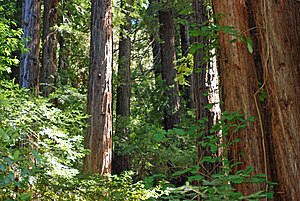Jasper Ridge Biological Preserve



The Jasper Ridge Biological Preserve is a 483 hectares (1,190 acres)[1] nature preserve and biological field station formally established as a reserve in 1973.[2][3] The biological preserve is owned by Stanford University, and is part of the Stanford School of Humanities and Sciences. It is located at 37°24′29″N 122°13′39″W / 37.408°N 122.2275°W[4] south of Sand Hill Road and west of Interstate 280 in Portola Valley, San Mateo County, California. It is used by students, researchers, and docents to conduct biology research, and teach the community about the importance of that research. The preserve encompasses Jasper Ridge and Searsville Lake (actually a reservoir) and the upper reaches of San Francisquito Creek, along with the latter's Corte Madera Creek and Bear Creek tributaries.
Geology
[edit]

Jasper Ridge is part of the foothills northeast of the Santa Cruz Mountains and is bounded by San Francisquito Creek, Corte Madera Creek and Los Trancos Creek, although the preserve occupies only the northwestern half of the ridge. The hilly mass runs about ten kilometers from northwest to southeast and about half that in width.[5]
Serpentine (Serpentinite) is the California State Rock. It was formed from deep sea or mantle rocks. This rock was squeezed toward the surface by tectonic plate movement, and thus feels greasy, as it has been polished over millions of years. Graywacke Sandstone after crossing Leonard's Bridge. This sandstone was part of the Franciscan formation 138 million years ago. Some rocks found at the preserve include: Greenstone, Chert, Serpentinite, Sandstone.
Ecology
[edit]In 1922, Cooper asserted that Jasper Ridge was historically chaparral, and cleared in the nineteenth century to open grasslands, primarily Eurasian wild oats (Avena fatua and Avena barbata).[5] However much of the grassland has been replaced by various oaks, especially Coast Live Oak (Quercus agrifolia), and Pacific Madrone (Arbutus menziesii). More recently, the oak/madrone forest is being succeeded by specimens of large Douglas fir (Pseudotsuga menziesii) as in the image above. In addition there are several groves of second growth Coast Redwoods (Sequoia sempervirens) in the preserve, some in large "fairy rings" indicating that trees of immense girth were cut down in the nineteenth century.
Academic studies
[edit]The Leslie Shao-ming Sun Field Station was built at Jasper Ridge in 2002. It is a 9,800 square foot sustainable, energy efficient green building, with a solar heating system and a 22kW grid-connected photovoltaic system. It was the first green building built on campus and was designed for zero net carbon emissions. It is home to office space for staff, a laboratory for research, the Jean Lane Environmental Education Classrooms, a reference library, and the Oakmead Herbarium. Numerous academic studies and ecological experiments are conducted at Jasper Ridge.[6]
Global change experiment
[edit]The Global Change Experiment studies the response of California annual grassland to global change, including elevated atmospheric CO2, temperature, altered precipitation, and increased nitrogen deposition.
Argentine ant invasion
[edit]This project studies and tracks the Argentine ants, an invasive species.
Bat monitoring
[edit]A station near the lake monitors bats at night, by converting and recording bat sounds (ultrasonic echolocation).
See also
[edit]References
[edit]- ^ "About the Preserve". Jasper Ridge Biological Preserve. Stanford University. Retrieved 29 January 2019.
- ^ "History". Jasper Ridge Biological Preserve. Stanford University. Retrieved 29 January 2019.
- ^ Jasper Ridge Biological Preserve Annual Report 2009-10 (Report). Stanford University School of Humanities and Sciences. 2010. Retrieved 2011-07-24.
- ^ U.S. Geological Survey Geographic Names Information System: Jasper Ridge Biological Preserve
- ^ a b William Skinner Cooper (1922). The broad-sclerophyll vegetation of California: an ecological study of the chaparral and its related communities. The Carnegie Institution of Washington. p. 31. ISBN 9780598851970. Retrieved 2011-06-19.
- ^ "Facilities & Infrastructure". Jasper Ridge Biological Preserve. Stanford University. Retrieved October 8, 2023; "Leslie Shao-ming Sun Field Station: A Case Study in Sustainable Design and Construction". Jasper Ridge Biological Preserve. Stanford University. Retrieved October 8, 2023.
